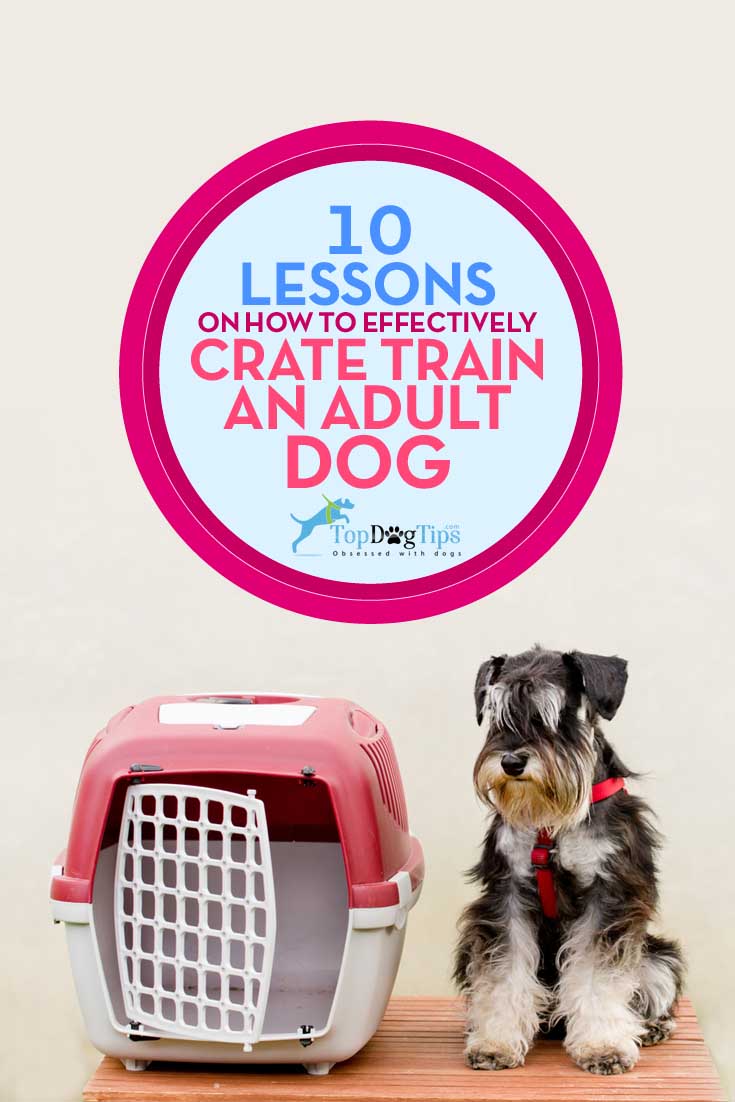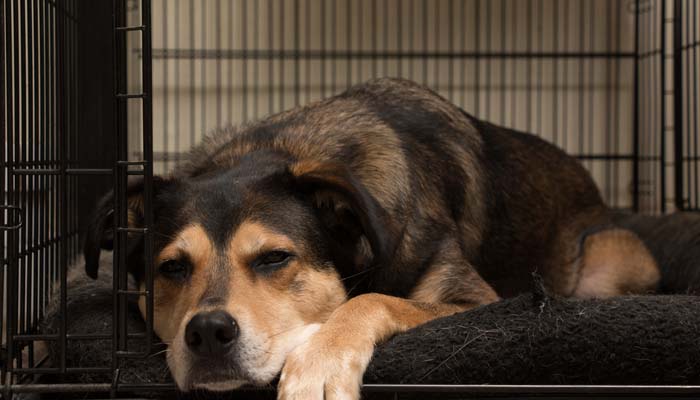Our dogs love their crates. But crate training an older dog is one of the most misunderstood ways of the house training process.
Tons of people are under the impression that it is cruel to crate a dog, but in reality, dogs are den creatures, and when they are crate trained properly they actually enjoy it.
Before we begin with this, I'd like to draw your attention to understanding the basics of dog training and canine psychology.
If you're new to this, I recommend an article 10 science-based dog training tricks written by Kristina Jovellar, MSc – it's eye opening.
Now, back to crate training a dog:
Even though Peta.org spreads misinformation about the “dangers” of using dog crates with your pets, many other canine experts and veterinarians agree that dogs actually love crates.
Canines are den animals, and they have a natural instinct to search for shelters where they would spend a big majority of their time.
Dogs use their pet crates for many things. That includes sleeping, resting, recovering, playing with toys, snacking and hiding.
When there are thunderstorms or 4th of July fireworks that we've just experienced, a dog crate is where your pooch will run to hide. It's his own fortress of safety.
Typically, after the dog becomes comfortable with his dog crate through crate training, he will go in it to rest when you’re home and the door is open.
It becomes their own home within your home.
Crate training an adult dog isn’t easy, and there are a few key things that you should know.
FULL GUIDE: How To Crate Train A Dog – Step by Step Instructions
How to Crate Training an Adult Dog: 10 Lessons
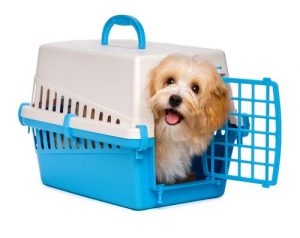 1. Choose the best dog crate
1. Choose the best dog crate
There are many different types and sizes of dog crates to choose from. Wire crates are most commonly used because they allow your dog to see what is going on around him.
These dog crates come with a sliding tray under the floor which makes them much easier to clean than soft-sided dog crates, nylon best dog crates or plastic ones.
Your dog's crate should be large enough for your pooch to stand up, turn around, and lie down comfortably. If the crate is too big, then your dog may use one area of the crate for sleeping and another to go to the bathroom. You want to avoid that.
2. Introduce your dog to the crate
When you're crate training an adult dog, maintain an uplifting composure, or your dog will learn to associate the crate with punishment.
Introduce your pet to his new home slowly, and observe the process in the beginning.
After a while, you can leave the dog to get accustomed to his dog crate.
A good way to start is by feeding your dog in the dog crate which allows the pet to associate the crate with a positive thing right from the start.
You should never force your dog into the crate. Allow your pet to explore this new place on his own until he's comfortable walking in and out of it.
RELATED: 5 Best Crates for Dogs
3. Locking the dog crate
Once the dog is comfortable going in and out of the crate, it is time to start getting him used to being locked inside of the crate.
Start with small increments. Yes, you will probably have to withstand some whining in the beginning; it's part of the process.
In the very beginning of this stage, as part of crate training an adult dog, you may sit in the room or by your dog while he's in the crate and talk to him, make him feel comfortable.
Then you can slowly leave the room for longer increments of time so he will get used to being locked in the crate by himself.
RELATED: How to Stop Your Dog From Pooping in House or Dog Crate
4. Train your dog not to bark or whine in the crate
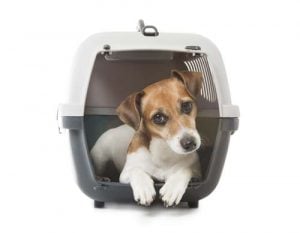 You don’t want to give your dog the impression that barking or whining will get him out of the dog crate.
You don’t want to give your dog the impression that barking or whining will get him out of the dog crate.
Instead, when you are crate training adult dog, spend time next to him while he is in the crate until he gets used to it.
Do not reward barking, but also do not punish for it.
If your pooch begins to bark or whine, then firmly tell him “no” and then wait until he stops before letting him out.
If you let him out while he is barking or whining, then he may begin to think that it is because he was making that noise that you let him out.
Read some more advice on using command training to stop dog barking if you cannot find a way to stop this process.
5. Remove all dog collars and clothing
Be sure to remove your pet’s collar or any clothing before you lock him inside of a dog crate.
Even flat buckle collars or very simple dog collars that are there only for style could get stuck in the bars of a crate and cause harm to your dog while you are away.
If you must put a collar on your dog, then be sure that it is a safety collar that “breaks away” if the dog gets caught on anything.
Do not use any type of shock collars or similar types of training collars that may hurt your pet while he's in the crate and when you're not observing him.
RELATED: 5 Best Dog Cage Covers for Dog Crates
6. Do not leave food inside of a dog crate
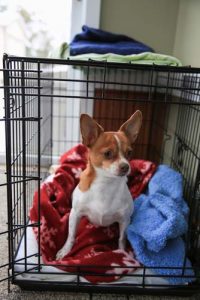 Leaving dog food or dog treats in the crate while you’re gone is a good way to end up with a mess when you return home.
Leaving dog food or dog treats in the crate while you’re gone is a good way to end up with a mess when you return home.
It is best to feed your dog before leaving or after you get home so he doesn't have to hold excrement in all day while you are gone.
Generally, some owners do leave a treat after the dog gets inside of a crate, and that's fine.
This rewards your pet's positive behavior, curbs the appetite, and that treat will also be gone as soon as you let it go off your hand.
Dog food, however, is a different topic.
7. Supply water
Your dog will need water inside of a crate while you are gone and he's locked in there. You don’t want to simply leave a bowl in the corner because chances are your dog will tip it over while you’re gone. Instead, when crate training adult dog, there are some ways to go about it.
Normally, you would use a special designed dog bowl. There are doggy water bowls that attach firmly to the side of dog crates. These are very convenient (here's one that I've used before). You could also use a water bottle, much like a giant hamster water bottle, to provide your dog with water that can’t be spilled.
8. Crating guidelines
 The Humane Society of The United States recommends that no dog should be crated for more than 6 hours.
The Humane Society of The United States recommends that no dog should be crated for more than 6 hours.
They also recommend that pet owners follow these crate training adult dog crating duration guidelines:
- 9-10 weeks No more than 60 minutes
- 11-16 weeks No more than 4 hours
- 17+ weeks No more than 6 hours
You may find this insignificant, but it's important to follow these rules to a letter. It's best for the dog, for you, and generally for the successful result of your dog's crate training.
9. Provide entertainment for the dog
Think of how boring it must for your dog to sit in his dog crate and wait for you to come home.
To ensure your pooch isn't dying from boredom, provide some indestructible dog chew toys to give your dog some entertainment when you leave.
Your dog will get some mental stimulation and entertainment from playing with his dog toys in the crate.
He will also start associating being in a crate with this positive process of playing with toys, and it will get easier and easier to continue crate training the dog.
RELATED: 10 Tips on How to Keep Your Dog From Running Away
10. NEVER use a dog crate as punishment
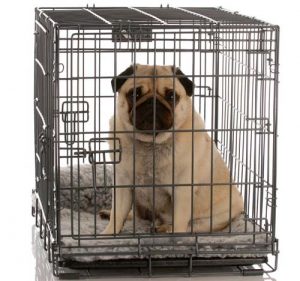 This is one of the most important rules of crate training adult dog.
This is one of the most important rules of crate training adult dog.
No owner should ever use a crate to punish their dog for misbehavior.
This will completely ruin your and his experience and may be very difficult to reverse.
Using the crate as a punishment will only cause your dog to fear and resent the crate. Then it will become a struggle to get him to go into the crate when you need him to.
You can use it as a “time-out” space when your dog needs to settle down, but do not force him into it as a negative punishment for doing something naughty.
Crate Training An Adult Dog: Closing Thoughts
Now you understand that there are guidelines for successfully crate training an adult dog.
Let's recap the lessons we went through:
- Choose the best crate for them
- Introduce them to the crate
- Get them used to being locked inside
- Train your dog not to bark or whine in the crate (reward training, NOT punishment)
- Remove any collar or clothing that could get snagged in the crate
- NEVER leave food in the crate
- Make sure they have access to water
- No more than 6 hours in crate at one time
- Give them things that will entertain them
- NEVER use the crate as punishment
It takes more patience than it does with a puppy because of its upbringing before you.
You can also use the same lessons for crate training an older dog.
Get out there and train your dog!
WATCH NEXT: How To Housetrain An Adult Dog 101 – Step by Step Instructions
